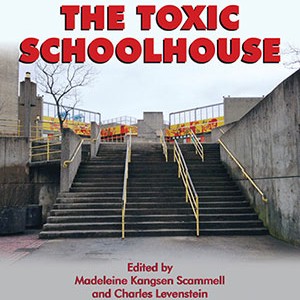About Ventilation Standards 2000 According to current minimum standards for indoor air quality, it is acceptable if up to 20% of adult building occupants are unsatisfied. Tang Lee, Professor of Building Science, University of Calgary tells us, “The Canadian building code references ASHRAE 62-1989 Ventilation for Acceptable Indoor Air Quality.… read more →
THE ECONOMICS OF GOOD IAQ Tedd Nathanson Senior Engineer, Building Air Quality Public Works and Government Services Canada Ottawa Canada K1A 0M2 [e-mail: NATHANST@PWGSC.GC.CA] INTRODUCTION Salary dollars are the single, most important cost in an office building, being more than two orders of magnitude (100 times) more than energy costs… read more →
Book Review: The Toxic Schoolhouse, edited by Madeleine Kangsen Scammell and Charles Levenstein Updated: 04/11/2014 Book Review: The Toxic Schoolhouse Baywood Publishing Company, Amityville, New York, http://baywood.com, edited by Madeleine Kangsen Scammell and Charles Levenstein, 2014. Parents should be able to assume that school buildings are healthy places for children, but… read more →
The following article was featured in the Winter 2001 issue of AVISO, the magazine of the Nova Scotia Teachers’ Union. CASLE recognizes that articles such as this can raise the level of knowledge about indoor air quality and can help prevent harm to teachers’ health and well being. Sick Schools… read more →
Examples of Hazardous Incidents in Schools: an article of historical significance that is still relevant. This is a partial list of hazardous incidents in schools that occurred in a one year period, 1995 to 1996. The list was sent to several government ministers in 1996 to demonstrate that action was… read more →
There are school indoor environment issues over which school administrators have control. (These are in addition to, although sometimes partnered with, the building management team’s responsibilities.) This guide contains: Essential information on environmental impacts on learning ability and health of normal individuals and also on those with existing health problems.… read more →
Guidelines to Accommodate Students and Staff with Environmental Sensitivities: A Guide for Schools On Healthy Schools Day 2010, Women’s College Hospital’s Environmental Health Clinic and CASLE released this guide to help schools accommodate students and staff with environmental sensitivities. Approximately 3 per cent of Canadians have been diagnosed with environmental… read more →
If you are wondering “Where do I start?”, then this is the must have collection for you. The articles below are the essential information sources you will need to get started to make your school a healthier place. Air Quality Testing Why children are more vulnerable Some less expensive ways… read more →
From www.HeadLice.Org Alternative Treatments: What the NPA Is Saying About Mayonnaise, Vaseline and Tea Tree Oil SAFETY WARNING: Oils may enhance absorption, therefore, avoid using oil treatments, or oil based hair dressings or conditioners immediately before and after applying pesticidal shampoos. Non-toxic remedies are obviously a preferred choice over pesticides… read more →



